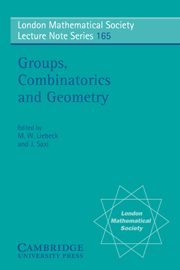Book contents
- Frontmatter
- Contents
- Authors' Addresses
- Introduction
- Part 1 Sporadic groups
- Part 2 Moonshine
- Part 3 Local and geometric methods in group theory
- Part 4 Geometries and related groups
- Part 5 Finite and algebraic groups of Lie type
- Part 6 Finite permutation groups
- Part 7 Further aspects of simple groups
- Part 8 Related topics
- 36 The orbifold notation for surface groups
- 37 A remark on two Diophantine equations of Peter Cameron
- 38 Testing for isomorphism between finitely presented groups
- 39 Discrete groups and, Galois theory
36 - The orbifold notation for surface groups
Published online by Cambridge University Press: 07 September 2010
- Frontmatter
- Contents
- Authors' Addresses
- Introduction
- Part 1 Sporadic groups
- Part 2 Moonshine
- Part 3 Local and geometric methods in group theory
- Part 4 Geometries and related groups
- Part 5 Finite and algebraic groups of Lie type
- Part 6 Finite permutation groups
- Part 7 Further aspects of simple groups
- Part 8 Related topics
- 36 The orbifold notation for surface groups
- 37 A remark on two Diophantine equations of Peter Cameron
- 38 Testing for isomorphism between finitely presented groups
- 39 Discrete groups and, Galois theory
Summary
“Even quite ungainly objects, like chairs and tables, will become almost spherical if you wrap them in enough newspaper.”
The symmetries of any finite object, such as a chair or a table, all fix a point, say the centre of gravity of the object, and so act on the surface of a sphere, for example any sphere centred on the centre of gravity.
The symmetries of a repeating pattern on a carpet or tiled floor, or on a wall, supposed continued to infinity, will probably constitute one of the 17 plane crystallographic groups.
Among the works of the Dutch draughtsman Maurits C. Escher, one can find examples of all these 17 groups, and also some even more interesting designs such as Circle Limit I, II, …, whose symmetries are various discrete groups of isometries of the hyperbolic plane.
In this paper a surface group will be a discrete group of isometries of one of the following three surfaces:
the sphere
the Euclidean plane
the hyperbolic plane.
These are all the simply-connected surfaces of constant Gaussian curvature. We shall present a simple and uniform notation that describes all three types of group. Since this notation is based on the concept of orbifold introduced by Bill Thurston, we shall call it the orbifold notation.
Roughly speaking, an orbifold is the quotient of a manifold by a discrete group acting on it. It therefore has one point for each orbit of the group on the manifold (Orbifold = Orbit-manifold).
Mirrors and mirror-boundaries
An orbifold may have boundary curves even though our three original surfaces do not. The boundary points arise from points lying on mirrors.
Information
- Type
- Chapter
- Information
- Groups, Combinatorics and Geometry , pp. 438 - 447Publisher: Cambridge University PressPrint publication year: 1992
Accessibility standard: Unknown
Why this information is here
This section outlines the accessibility features of this content - including support for screen readers, full keyboard navigation and high-contrast display options. This may not be relevant for you.Accessibility Information
- 24
- Cited by
